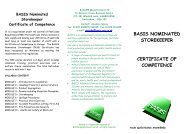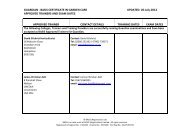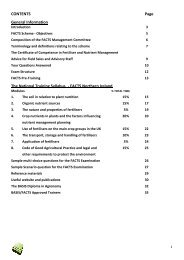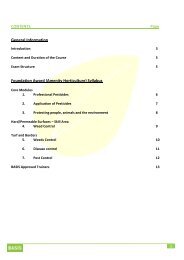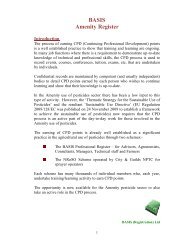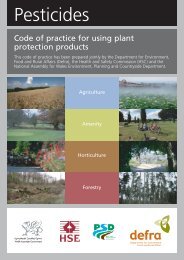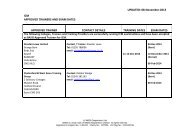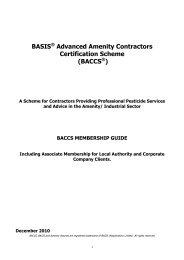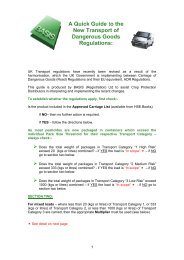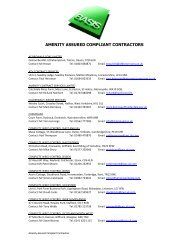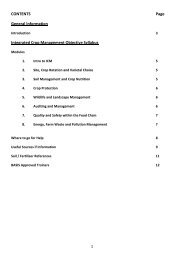BASIS Certificate in Crop Protection (Stored Potatoes) Objective ...
BASIS Certificate in Crop Protection (Stored Potatoes) Objective ...
BASIS Certificate in Crop Protection (Stored Potatoes) Objective ...
Create successful ePaper yourself
Turn your PDF publications into a flip-book with our unique Google optimized e-Paper software.
<strong>BASIS</strong> <strong>Certificate</strong> <strong>in</strong> <strong>Crop</strong> <strong>Protection</strong> (<strong>Stored</strong> <strong>Potatoes</strong>) <strong>Objective</strong> SyllabusGeneral Information 2Exam<strong>in</strong>ation Guidel<strong>in</strong>es 4Modules1. Integrated Store Management and Sprout Suppression, Stor<strong>in</strong>g<strong>Potatoes</strong> to meet Market requirements 52. Recognition, Biology and Control of Storage Pests 73. Recognition, Biology and Control of Storage Diseases 84. Composition, Activity and Persistence of <strong>Crop</strong> <strong>Protection</strong>Chemicals and Biological Agents 105. Application of <strong>Crop</strong> <strong>Protection</strong> Chemicals used for the treatment of<strong>Stored</strong> <strong>Potatoes</strong> and Storage Build<strong>in</strong>gs 126. Safe Use, Handl<strong>in</strong>g, Transport and Storage of <strong>Crop</strong> <strong>Protection</strong> Chemicalsused for the treatment of <strong>Stored</strong> <strong>Potatoes</strong> and Storage Build<strong>in</strong>gs14Useful Websites & Publications 17<strong>BASIS</strong> Approved Tra<strong>in</strong>ers 181
<strong>BASIS</strong> CERTIFICATE IN CROP PROTECTION(<strong>Stored</strong> <strong>Potatoes</strong>)SYLLABUS & INFORMATIONThe <strong>BASIS</strong> <strong>Certificate</strong> <strong>in</strong> <strong>Crop</strong> <strong>Protection</strong> (Agriculture) has been established s<strong>in</strong>ce 1978 to provide tra<strong>in</strong><strong>in</strong>g andcertification for sellers of agrochemicals and those giv<strong>in</strong>g advice on their use.In 1985 the Food & Environment <strong>Protection</strong> Act (FEPA) made certification a statutory obligation for pesticidesellers.“No person shall sell, supply or otherwise market to the end-user a pesticide approved for agricultural use unlesshe has obta<strong>in</strong>ed a certificate of competence recognised by the M<strong>in</strong>isters, or he sells or supplies that pesticideunder the direct supervision of a person who holds such a certificate”The <strong>BASIS</strong> <strong>Certificate</strong> <strong>in</strong> <strong>Crop</strong> <strong>Protection</strong> (<strong>Stored</strong> <strong>Potatoes</strong>) is <strong>in</strong>tended for those who will only sell, and/or giveadvice, on the use of pesticides that are used <strong>in</strong> stored potatoes, or used for the treatment of the fabric ofpotato storage build<strong>in</strong>gs. It does not cover sales of, or advice regard<strong>in</strong>g, pesticides used <strong>in</strong> grow<strong>in</strong>g crops.Anyone who will sell or advise on pesticides used <strong>in</strong> the field must obta<strong>in</strong> the broader <strong>BASIS</strong> <strong>Certificate</strong> <strong>in</strong> <strong>Crop</strong><strong>Protection</strong> (Agriculture, Commercial Horticulture or Vegetables).This booklet is designed to help those <strong>in</strong>volved with tra<strong>in</strong><strong>in</strong>g people to meet the standard and provide guidel<strong>in</strong>esto the subject areas which need to be covered to enable them to achieve a satisfactory level of competence.It is essential that candidates understand the need for a practical approach to tra<strong>in</strong><strong>in</strong>g because <strong>in</strong> order to besuccessful, <strong>in</strong>dividuals must be able to give sound technical advice. Obviously some of the tra<strong>in</strong><strong>in</strong>g will be of atheoretical nature but both the syllabus and tra<strong>in</strong><strong>in</strong>g programme should be <strong>in</strong>terpreted to provide practical<strong>in</strong>struction wherever possible.All staff employed <strong>in</strong> the field sales of agrochemicals and/or giv<strong>in</strong>g advice on their use must, under the Control ofPesticides (Amendment) Regulations 1997, have obta<strong>in</strong>ed a <strong>Certificate</strong> of Competence or exemption from itwith<strong>in</strong> three years of enter<strong>in</strong>g the <strong>Crop</strong> <strong>Protection</strong> <strong>in</strong>dustry. New staff to the <strong>in</strong>dustry will be allowed a period ofthree years <strong>in</strong> which to qualify, dur<strong>in</strong>g which they will be work<strong>in</strong>g under the supervision of a qualified member ofstaff.Candidates must have had satisfactory tra<strong>in</strong><strong>in</strong>g and supervised field experience before enter<strong>in</strong>g for the <strong>BASIS</strong>exam<strong>in</strong>ations. If <strong>in</strong> doubt as to this requirement, please contact the <strong>BASIS</strong> office. Remember, new entrants tothe <strong>in</strong>dustry are given up to three years work<strong>in</strong>g under supervision before be<strong>in</strong>g required to hold the <strong>BASIS</strong><strong>Certificate</strong> <strong>in</strong> <strong>Crop</strong> <strong>Protection</strong>.It is recommended that a tra<strong>in</strong><strong>in</strong>g course of at least two days is undertaken prior to the exam<strong>in</strong>ation day. Inaddition, it is essential that candidates are issued with the course work book (available from <strong>BASIS</strong> [Registration]Ltd) at least two weeks prior to the tra<strong>in</strong><strong>in</strong>g. Candidates will need to complete the questions <strong>in</strong> the work book tomeet the required level of knowledge.The work book is designed to be used as part of a tra<strong>in</strong><strong>in</strong>g course.2
By attempt<strong>in</strong>g to answer the questions at the end of each module <strong>in</strong> the work book, candidates will <strong>in</strong>creasetheir knowledge and understand<strong>in</strong>g. Not all of the <strong>in</strong>formation they will need is <strong>in</strong> this book, some will comefrom the tra<strong>in</strong><strong>in</strong>g course and some additional work is also necessary. A list of useful websites and publications is<strong>in</strong>cluded <strong>in</strong> the work book.Courses are offered for the <strong>BASIS</strong> <strong>Certificate</strong> <strong>in</strong> <strong>Crop</strong> <strong>Protection</strong> (<strong>Stored</strong> <strong>Potatoes</strong>) by the <strong>BASIS</strong> Approved Tra<strong>in</strong>erslisted <strong>in</strong> this booklet (Page 20).Whistle Blow<strong>in</strong>g Policy<strong>BASIS</strong> (Registration) Ltd is committed to the highest standards of openness and accountability. Therefore, weexpect employees, candidates and others who work with <strong>BASIS</strong> who have serious concerns about any aspect ofour work voice those concerns.To this effect <strong>BASIS</strong> has a whistle Blow<strong>in</strong>g Policy. This procedure is designed to allow concerns of a public <strong>in</strong>terestk<strong>in</strong>d with<strong>in</strong> <strong>BASIS</strong> to be raised, <strong>in</strong>vestigated and where appropriate, acted upon. Compla<strong>in</strong>ts may be any memberof staff, candidates or those contracted to provide services to <strong>BASIS</strong>.To view the full Whistle Blow<strong>in</strong>g Policy go to:http://www.basis-reg.co.uk/media/documents/430/<strong>in</strong>dex.htmlDyslexia Policy<strong>BASIS</strong> (Registration) Ltd allows students diagnosed with Dyslexia to request special exam<strong>in</strong>ation arrangements.Proof of dyslexia is required a m<strong>in</strong>imum of 4 weeks before the exam date so that <strong>BASIS</strong> can provide specialexam<strong>in</strong>ation arrangements if required.For a full copy of our Dyslexia Policy please go to:http://www.basis-reg.co.uk/media/documents/TM%2015%20<strong>BASIS</strong>%20Dyslexia%20Policy%20-%20Sept%202011.pdf3
EXAMINATION GUIDELINESIntroductionExam<strong>in</strong>ations are held by Tra<strong>in</strong><strong>in</strong>g Providers who have been runn<strong>in</strong>g tra<strong>in</strong><strong>in</strong>g courses for the <strong>BASIS</strong> <strong>Certificate</strong> <strong>in</strong><strong>Crop</strong> <strong>Protection</strong> (<strong>Stored</strong> <strong>Potatoes</strong>) <strong>in</strong> various parts of the UK. The exam<strong>in</strong>ation consists of a multi-choice andshort-answer question paper.Overall Standard for Exam<strong>in</strong>ationThe <strong>BASIS</strong> certificate was orig<strong>in</strong>ally aimed at pesticide sales staff and advisers with<strong>in</strong> thedistributor/manufacturer trade, and <strong>in</strong>dependent advisers. However, s<strong>in</strong>ce the <strong>in</strong>ception of the variousassurance schemes, there has been an upsurge of <strong>in</strong>terest from farmers, growers and other organisations toobta<strong>in</strong> the <strong>BASIS</strong> qualification.The overall aim of the exam<strong>in</strong>ation is to determ<strong>in</strong>e whether candidates have understood the basic pr<strong>in</strong>ciplesrelat<strong>in</strong>g to pesticides, detailed with<strong>in</strong> the <strong>BASIS</strong> (<strong>Stored</strong> <strong>Potatoes</strong>) syllabus. Candidates who successfully pass the<strong>BASIS</strong> <strong>Certificate</strong> <strong>in</strong> <strong>Crop</strong> <strong>Protection</strong> (<strong>Stored</strong> <strong>Potatoes</strong>) cannot necessarily classify themselves as “experienced”advisers; this will depend on the <strong>in</strong>dividual’s experience or will come over time with<strong>in</strong> the <strong>in</strong>dustry. We must besure of candidates’ ability, not only to grasp the basic pr<strong>in</strong>ciples of <strong>Crop</strong> <strong>Protection</strong>, but also that they areconsidered to give safe recommendations and understand the environmental issues <strong>in</strong>volved, along withrelevant current legislation.EXAMINATION GUIDELINESQuestion PaperQuestions for the paper are validated by a Technical Panel. The paper consists of 40 multi-choice questions andthree short answer questions to be completed with<strong>in</strong> two hoursa) multi-choice and short-answer question paperPass mark – 70%4
OBJECTIVE SYLLABUSThe syllabus has been designed to allow <strong>in</strong>dividual sections of tra<strong>in</strong><strong>in</strong>g to be treated as separate units for tra<strong>in</strong><strong>in</strong>gpurposes.1.1 CompetenceMODULE 1 - INTEGRATED STORE MANAGEMENT AND SPROUT SUPPRESSION,STORING POTATOES TO MEET MARKET REQUIREMENTSDemonstrate knowledge and understand<strong>in</strong>g of the concept and importance of Integrated Store Management.Expla<strong>in</strong> the role of good potato store management <strong>in</strong> meet<strong>in</strong>g the requirements of different end markets.1.2 Performance CriteriaCandidates will be able to:• def<strong>in</strong>e Integrated Store Management.• show understand<strong>in</strong>g of the importance of Integrated Store Management.• identify the components of Integrated Store Management.• state good sources of <strong>in</strong>formation on Integrated Store Management.• demonstrate an understand<strong>in</strong>g of the requirements of different end markets• demonstrate a knowledge of the role, operation, and requirements of crop assurance schemes• show understand<strong>in</strong>g of the importance and requirements of Food Safety legislation• appreciate the range of factors beyond the control of a store manager which affect whether end marketrequirements are met. For example pest and disease problems <strong>in</strong> the crop before harvest or damage atharvest.• expla<strong>in</strong> the roles of hygiene, monitor<strong>in</strong>g, calibration and record<strong>in</strong>g <strong>in</strong> good store management.• show an understand<strong>in</strong>g of the importance of store design, construction and ma<strong>in</strong>tenance <strong>in</strong> the control ofstorage problems.• Expla<strong>in</strong> the methods used to prevent sprout<strong>in</strong>g, <strong>in</strong>clud<strong>in</strong>g temperature control, CIPC fogg<strong>in</strong>g and ethylenegeneration.• Understand the sampl<strong>in</strong>g procedure for CIPC residue test<strong>in</strong>g• Understand the function and implications of the Store Checklist and Critical Failure Po<strong>in</strong>t• Have full knowledge of the CIPC application procedures <strong>in</strong> box and bulk stores.5
1.3 Essential Knowledge & SkillsCandidates must have the ability to:• understand why an <strong>in</strong>tegrated approach to potato store management is necessary to ma<strong>in</strong>ta<strong>in</strong> quality ofstored potato crops• recognise the major factors <strong>in</strong>fluenc<strong>in</strong>g the quality of stored potato crops• use all appropriate criteria to assess the threats to stored potato quality <strong>in</strong> a particular system or store• understand the pr<strong>in</strong>ciples of monitor<strong>in</strong>g and manag<strong>in</strong>g stored potato temperatures• expla<strong>in</strong> the critical issues to be considered when cool<strong>in</strong>g potato crops post harvest• understand the pr<strong>in</strong>ciples of monitor<strong>in</strong>g and manag<strong>in</strong>g humidity <strong>in</strong> stored potato crops• expla<strong>in</strong> the critical issues to be considered when load<strong>in</strong>g and cur<strong>in</strong>g potato crops post harvest• outl<strong>in</strong>e key differences <strong>in</strong> the management of ware, process<strong>in</strong>g and seed potato crops• identify the features of good storage systems• describe practical steps which should be taken to prepare a store and crop handl<strong>in</strong>g equipment prior toharvest• expla<strong>in</strong> how the design of build<strong>in</strong>gs and handl<strong>in</strong>g systems affects ability to manage quality dur<strong>in</strong>g storage ofpotato crops• describe good practices for load<strong>in</strong>g, cur<strong>in</strong>g and ‘pull-down’ of temperature• expla<strong>in</strong> the importance of produc<strong>in</strong>g safe produce that meets quality specifications and outl<strong>in</strong>e key aspectsof a store management plan which contribute to this• expla<strong>in</strong> the roles of assurance schemes and of legislation <strong>in</strong> achiev<strong>in</strong>g food safety• demonstrate knowledge of the sections of the Assured Produce <strong>Crop</strong> Specific Protocol for <strong>Potatoes</strong> deal<strong>in</strong>gwith storage, sprout suppressants and storage fungicides• identify specific storage and handl<strong>in</strong>g issues which represent particular food safety hazards; expla<strong>in</strong>measures required to elim<strong>in</strong>ate the hazard or m<strong>in</strong>imise the risk• demonstrate good knowledge and understand<strong>in</strong>g of the Potato Council “Store Manager’s Guide” 2008• understand fully, and expla<strong>in</strong> <strong>in</strong> detail, the Potato Council best practice guidel<strong>in</strong>es for the use of CIPC sproutsuppressant• demonstrate good knowledge and understand<strong>in</strong>g of the Potato Industry CIPC Stewardship Group’s “Industrycode of practice for application of chlorpropham potato sprout suppressant”• Expla<strong>in</strong> the CIPC application procedures for box and bulk stores• Use the Store Checklist to identify control po<strong>in</strong>ts and ensure compliance to CIPC application requirements.• Understand the implications for CIPC MRL exceedencies6
MODULE 2 - RECOGNITION, BIOLOGY AND CONTROL OF STORAGE PESTS2.1 Competence• Ability to recognise pests and pest damage, to anticipate and prevent pest problems and to choose safe andappropriate control measures.2.2 Performance CriteriaCandidates will be able to:• demonstrate an awareness of the factors that determ<strong>in</strong>e the occurrence of pest damage and its importance• expla<strong>in</strong> the importance of vertebrate pests, and the practical measures used to exclude and manage them• show knowledge and understand<strong>in</strong>g of the methods available to prevent or control vertebrate pest damage2.3 Essential Knowledge & SkillsCandidates must have the ability to:• relate pest <strong>in</strong>cidence to particular store problems or management practices• select store management practices that may be used to m<strong>in</strong>imise pest damage• identify pest damage which cannot be controlled by store management or by post-harvest treatment, e.g.slug damage• choose appropriate control measures for particular pest problems• identify the special features of mammal biology that contribute to pest problems caused by these animals• identify pest damage symptoms and signs of rodent pests• recommend and justify specific control measures• expla<strong>in</strong> what is meant by resistance (to anti-coagulant rodenticides)• detail the CRRU guidel<strong>in</strong>es for responsible rodenticide use7
MODULE 3 - RECOGNITION, BIOLOGY AND CONTROL OF STORAGE DISEASES3.1 CompetenceRecognition of disease symptoms, the evaluation of disease problems and choice of appropriate controlmeasures.3.2 Performance CriteriaCandidates will be able to:• identify symptoms of major diseases <strong>in</strong> stored potato crops• expla<strong>in</strong> the significance of diseases which develop or <strong>in</strong>crease <strong>in</strong> store and demonstrate awareness of themethods of assessment and evaluation• show an understand<strong>in</strong>g of the biology of common micro-organisms which can develop <strong>in</strong> stored potato crops• demonstrate an understand<strong>in</strong>g of methods available for control, reduction and prevention of diseases• identify the notifiable diseases which may be found <strong>in</strong> stored potatoes, and understand the notificationrequirements• show awareness of the significance and implications of fungicide resistance3.3 Essential Knowledge & SkillsCandidates must have the ability to:• recognise the symptoms of the important potato diseases which can develop or <strong>in</strong>crease <strong>in</strong> store e.g. silverscurf, black dot, sk<strong>in</strong> spot, dry rot, gangrene and soft rots• recognise the symptoms of the notifiable potato tuber diseases e.g. r<strong>in</strong>g rot and brown rot• expla<strong>in</strong> the significance of disease development <strong>in</strong> stored potato crops• assess and record disease <strong>in</strong> stored potato crops• demonstrate awareness of the economic significance of damage• relate conditions <strong>in</strong>fluenc<strong>in</strong>g the survival, build-up and dispersal of fungi and bacteria to the development ofstorage problems• expla<strong>in</strong> environmental <strong>in</strong>fluences on the development of fungal and bacterial growth <strong>in</strong> stored potato crops8
• use a knowledge of the factors <strong>in</strong>fluenc<strong>in</strong>g microbial development to recommend specific measures tomanage and prevent disease development.• select and justify appropriate measures for prevention and treatment of diseases• expla<strong>in</strong> the importance of harvest<strong>in</strong>g date, management of store temperature and tuber dry<strong>in</strong>g <strong>in</strong> the controlof diseases• demonstrate knowledge of the manufacturer’s stewardship guidel<strong>in</strong>es for the use of imazalil products• expla<strong>in</strong> the significance of fungal resistance to thiabendazole9
MODULE 4 - COMPOSITION, ACTIVITY AND PERSISTENCE OF CROP PROTECTION CHEMICALS, AND BIOLOGICALAGENTS4.1 CompetenceTo develop an understand<strong>in</strong>g of the nature of crop protection chemicals used <strong>in</strong> potato crop storage4.2 Performance CriteriaCandidates will be able to:• ensure the correct use of technical terms• understand the composition of relevant crop protection materials• develop an awareness of the use of biological control agents and their limitations• expla<strong>in</strong> clearly the biological activity of important groups of fungicides and sprout suppressants• expla<strong>in</strong> why persistence is an important issue• show an understand<strong>in</strong>g of factors <strong>in</strong>fluenc<strong>in</strong>g persistence• understand factors <strong>in</strong>fluenc<strong>in</strong>g the development of resistance to pesticide materials by target organisms4.3 Essential Knowledge & SkillsCandidates must have the ability to:• expla<strong>in</strong> the use of chemical names, approved common names and proprietary names for relevant cropprotection materials• classify relevant crop protection materials <strong>in</strong>to functional, chemical and mode of action categories• accurately def<strong>in</strong>e terms used <strong>in</strong> relation to chemical treatments• describe the types of formulations used for relevant products and understand the significance of formulationfor efficacy, safety, packag<strong>in</strong>g and ease of use• understand the basic functions of additives, such as surfactants, diluents, and dispers<strong>in</strong>g, dispens<strong>in</strong>g andemulsify<strong>in</strong>g agents• expla<strong>in</strong> the significance and limitations of different formulations <strong>in</strong> relation to application, activity, selectivity,toxicology and persistence10
• expla<strong>in</strong> the importance of compliance with manufacturers’ <strong>in</strong>structions for correct application of particularformulations.• outl<strong>in</strong>e the mode of action of major groups of rodenticides• show a knowledge of the properties of materials which <strong>in</strong>fluence biological activity, selectivity and humantoxicity• describe the likely <strong>in</strong>fluence of environmental factors such as temperature and moisture on the effectivenessand behaviour of particular materials• expla<strong>in</strong> the limitations of particular materials• understand the importance of pesticide storage conditions on the activity of products.• expla<strong>in</strong> the possible reasons for the <strong>in</strong>effectiveness of chemical treatments <strong>in</strong> particular situations. Forexample, poor coverage• give justification for the selection of certa<strong>in</strong> materials for particular situations• recognise the significance of approved and recommended uses of particular materials <strong>in</strong> relation topersistence.• recognise the significance of m<strong>in</strong>imum time <strong>in</strong>tervals between application of particular materials and theremoval from store for movement or use• show awareness of residue sampl<strong>in</strong>g programmes and knowledge of the sett<strong>in</strong>g and enforcement ofmaximum residue levels• give examples of resistance of target organisms to particular pesticides• outl<strong>in</strong>e how resistance <strong>in</strong> target organisms develops• expla<strong>in</strong> measures for limit<strong>in</strong>g the development of resistance.• recommend alternative materials <strong>in</strong> situations where resistance exists, or is likely to develop• detail alternative strategies of control to help manage problems of resistance, and prevent its possibledevelopment11
5.1 CompetenceMODULE 5 - APPLICATION OF CROP PROTECTION CHEMICALS USED FOR THE TREATMENT OF STOREDPOTATOES AND STORAGE BUILDINGSTo develop an understand<strong>in</strong>g of the equipment and techniques for apply<strong>in</strong>g potato storage pesticides5.2 Performance CriteriaCandidates will be able to:• develop a knowledge of formulations <strong>in</strong> relation to application treatments.• demonstrate knowledge of the types, and use, of equipment for application.• show awareness of the need for correct applicator use and ma<strong>in</strong>tenance and accurate applicationprocedures.• appreciate potential hazards associated with application and encourage safety.5.3 Essential Knowledge & SkillsCandidates must have the ability to:• develop a knowledge of the various types of formulations of products.• recognise the significance of formulation <strong>in</strong> relation to the choice of application equipment, and method ofdelivery of the material.• describe the practical limits of the accuracy of placement and coverage of particular materials.• give details of types of application treatment.• describe equipment used for application.• recognise the nature of tuber surfaces and also built (build<strong>in</strong>g fabric) surfaces, and their <strong>in</strong>fluence on thedegree of retention and distribution of chemicals.• expla<strong>in</strong> the importance of factors that <strong>in</strong>fluence the retention and distribution of chemicals on surfaces.• demonstrate a knowledge of the various types of application equipment.• understand the <strong>in</strong>teraction of factors such as pressure and nozzle size and type on droplet size and coverage.• identify major faults <strong>in</strong> application equipment12
• calculate the appropriate amount of product to be recommended <strong>in</strong> different situations• understand the need for carry<strong>in</strong>g out and record<strong>in</strong>g ma<strong>in</strong>tenance and calibration of equipment, and state theappropriate <strong>in</strong>tervals and times• demonstrate knowledge and understand<strong>in</strong>g of the Potato Council publication “Improv<strong>in</strong>g the use of CIPC <strong>in</strong>bulk stores” (2008)• identify potential hazards <strong>in</strong> carry<strong>in</strong>g out application and <strong>in</strong> ma<strong>in</strong>ta<strong>in</strong><strong>in</strong>g application equipment.• describe safe procedures for the handl<strong>in</strong>g of materials and their preparation for application.• describe procedures for ensur<strong>in</strong>g the safety of operators dur<strong>in</strong>g the application of crop protection materials.• recognise safe procedures for protect<strong>in</strong>g the general public, the consumer and the environment frompotential harm.• state the appropriate tra<strong>in</strong><strong>in</strong>g and certification for operators of both CIPC application equipment and rollertable applicators13
MODULE 6 - SAFE USE, HANDLING, TRANSPORT AND STORAGE OFCROP PROTECTION CHEMICALS USED FOR THE TREATMENT OF STORED POTATO CROPS AND STORAGEBUILDINGS6.1 CompetenceKnowledge of the hazards of crop protection chemicals, to encourage safety and an awareness of legalobligations.6.2 Performance CriteriaCandidates will be able to:• show a thorough understand<strong>in</strong>g of the human hazards presented by relevant pesticides and thecircumstances <strong>in</strong> which problems may occur.• demonstrate awareness of the potential for harmful effects of pesticides on the environment and knowledgeof how hazards can be elim<strong>in</strong>ated and risks m<strong>in</strong>imised.• outl<strong>in</strong>e the obligations and requirements of pesticide legislation at EU and national level• encourage safe practices and show a knowledge of the procedures and precautions that should be adopted.6.3 Essential Knowledge & SkillsCandidates must have the ability to:• identify the application procedures and formulations likely to give rise to the greatest contam<strong>in</strong>ation ofoperatives cloth<strong>in</strong>g, sk<strong>in</strong> and respiratory tract• recognise the <strong>in</strong>fluence of previous exposure on the toxicity of anti-chol<strong>in</strong>esterase compounds• recognise the hazards associated with uncontrolled access to crop protection operations, materials andstores, especially by children and domestic animals• give an explanation of the hazards associated with the transfer of pesticides <strong>in</strong>to <strong>in</strong>correctly labelledconta<strong>in</strong>ers• expla<strong>in</strong> the possible route of pesticide residues to the consumer• identify the factors that affect the level of pesticide residues <strong>in</strong> food14
• expla<strong>in</strong> how harm could be caused by use of approved products. For example, through <strong>in</strong>correct applicationor dose rates• understand how pesticides may come <strong>in</strong>to contact with stored potatoes not deliberately treated with them• show awareness of the purpose of the Authorisation Directive 91/414/EEC, FEPA 1985, COPR 1986 (Asamended) and PPPR 1995 (as amended)• outl<strong>in</strong>e the authorisation and approval process at EU and national level• expla<strong>in</strong> the major legal provisions controll<strong>in</strong>g the sale, supply, use and advertis<strong>in</strong>g of pesticides• use a pesticide product label and material safety data sheet to give appropriate advice on safe and effectiveuse of the product• show awareness of EC Regulation 396/2005 (EC) and be able to def<strong>in</strong>e what is meant by MRL• Expla<strong>in</strong> the purpose of MRLs and outl<strong>in</strong>e how they are enforced• understand the importance of and be aware of the relevant content of the Code of Practice for Us<strong>in</strong>g Plant<strong>Protection</strong> Products and also the Code of Practice for Suppliers of Pesticides, to GRICULTURE, Horticultureand Forestry (the “Yellow Code”).• show awareness of the Health and Safety at Work Act 1974 and the COSHH Regulations• understand the importance of a COSHH assessment and the role of Material Safety Data Sheets• use a Material Safety Data Sheet to determ<strong>in</strong>e <strong>in</strong>formation useful for a COSHH assessment• expla<strong>in</strong> the importance of appropriate choice of product and methods of application <strong>in</strong> reduc<strong>in</strong>g risks topeople, the environment and the consumer• describe the precautions to be taken dur<strong>in</strong>g the transport of pesticides• show awareness of best practice specifications for a pesticide store on a farm or hold<strong>in</strong>g• emphasise the importance of limit<strong>in</strong>g access to crop protection stores, crop stores and operations• describe work<strong>in</strong>g practices that will m<strong>in</strong>imise risk to operators• describe best practice for waste management <strong>in</strong> relation to pesticides, protective cloth<strong>in</strong>g and emptyconta<strong>in</strong>ers• describe the steps that should be taken if accidental human poison<strong>in</strong>g is suspected and the appropriatedecontam<strong>in</strong>ation procedures for cloth<strong>in</strong>g and sk<strong>in</strong>• understand the legal obligations concern<strong>in</strong>g consumers under the Food Safety Act 199015
• show awareness of the EU Water Framework Directive 2000/60/EC and of the Water Resources Act 1991.• expla<strong>in</strong> how <strong>in</strong>appropriate use, transport or storage of pesticides could lead to water pollution• show understand<strong>in</strong>g of the consequences of water pollution.16
<strong>BASIS</strong> <strong>Certificate</strong> <strong>in</strong> <strong>Crop</strong> <strong>Protection</strong> (<strong>Stored</strong> <strong>Potatoes</strong>)Must read (have):• Code of practice for us<strong>in</strong>g plant protection products, DEFRAhttp://www.pesticides.gov.uk/safe_use.asp?id=64 chris.pidgeon@hse.gsi.gov.uk• The UK Pesticide Guide (annually), BCPC http://www.bcpc.org/shop/UK-Pesticide-Guide-2011.html01420 593200• Yellow Code – Code of Practice for suppliers of pesticides to agriculture, horticulture and forestryUseful to read (have):• <strong>Crop</strong>s Magaz<strong>in</strong>e or <strong>Crop</strong>s Digital• Farmers Weekly• Potato Weekly• Potato Council publicationshttp://www.potato.org.uk/department/research_and_development/publications/<strong>in</strong>dex.html?cid=NA• Product manuals from manufacturers of crop protection products• Protect<strong>in</strong>g our Water, Soil and Air, DEFRAUseful websites• www.basis-reg.com• www.defra.gov.uk• www.hgca.com• www.niab.co.uk• www.pesticides.gov.uk• www.potato.org.uk• www.voluntary<strong>in</strong>itiative.org.uk17
<strong>BASIS</strong> APPROVED TRAINERSThe follow<strong>in</strong>g Colleges, Tra<strong>in</strong>ers and Tra<strong>in</strong><strong>in</strong>g Providers are successfully runn<strong>in</strong>g FSTS exam<strong>in</strong>ations and havebeen accepted as <strong>BASIS</strong> Approved Tra<strong>in</strong>ers for The <strong>BASIS</strong> <strong>Certificate</strong> (<strong>Stored</strong> <strong>Potatoes</strong>).James Christian-Ilett Tel. 016738609258 Pa<strong>in</strong>shall Close Email. christian.ilett@bt<strong>in</strong>ternet.comWeltonL<strong>in</strong>colnLN2 3NUJohn Horrocks Tel. 01162 8635991 Penn Craig Email. john.horrocks@pepsico.comHarolds LaneEnderbyLEICESTERLeicestershireLE19 4AF15 April 201318



